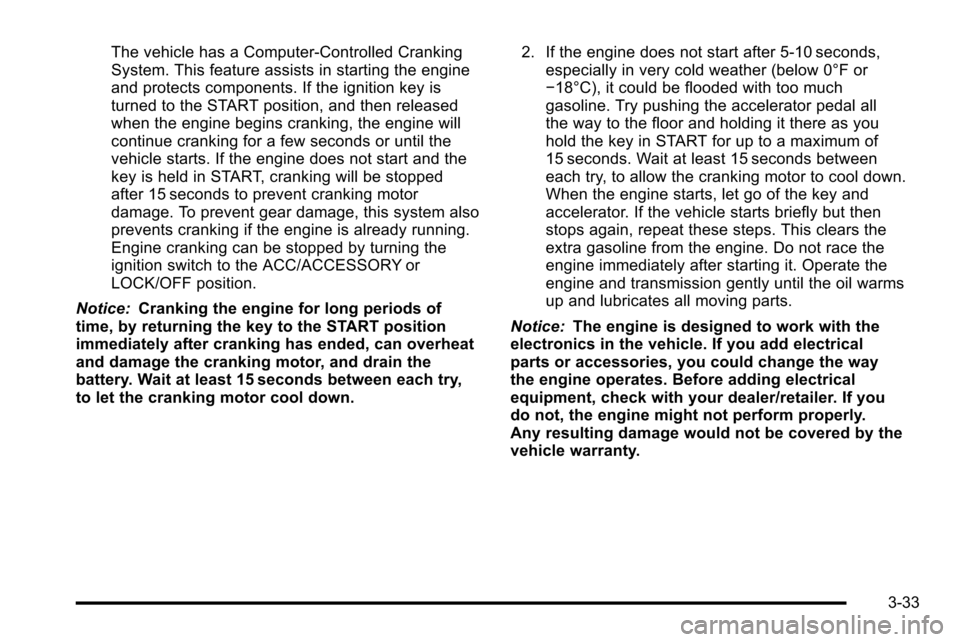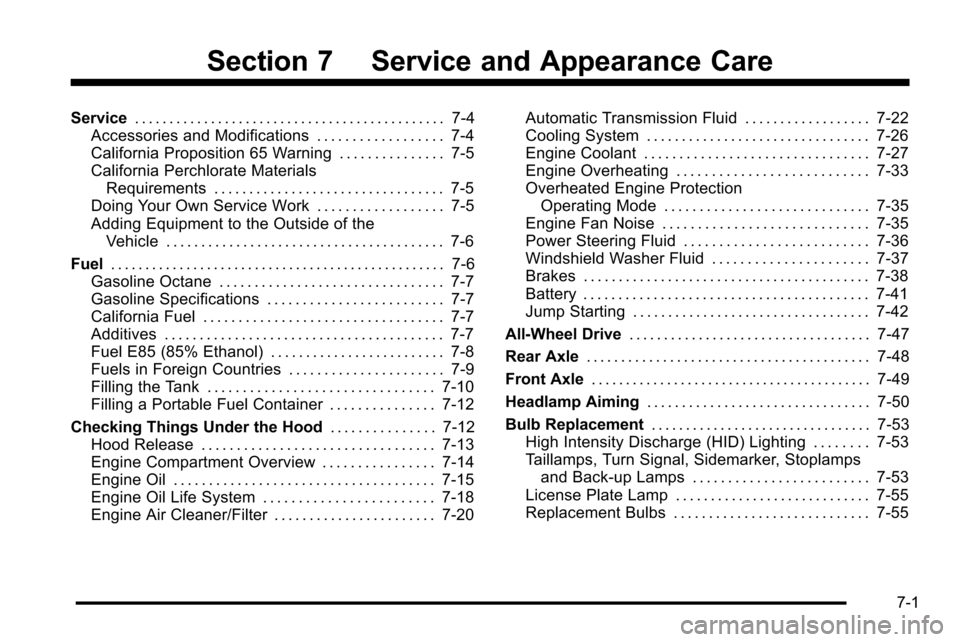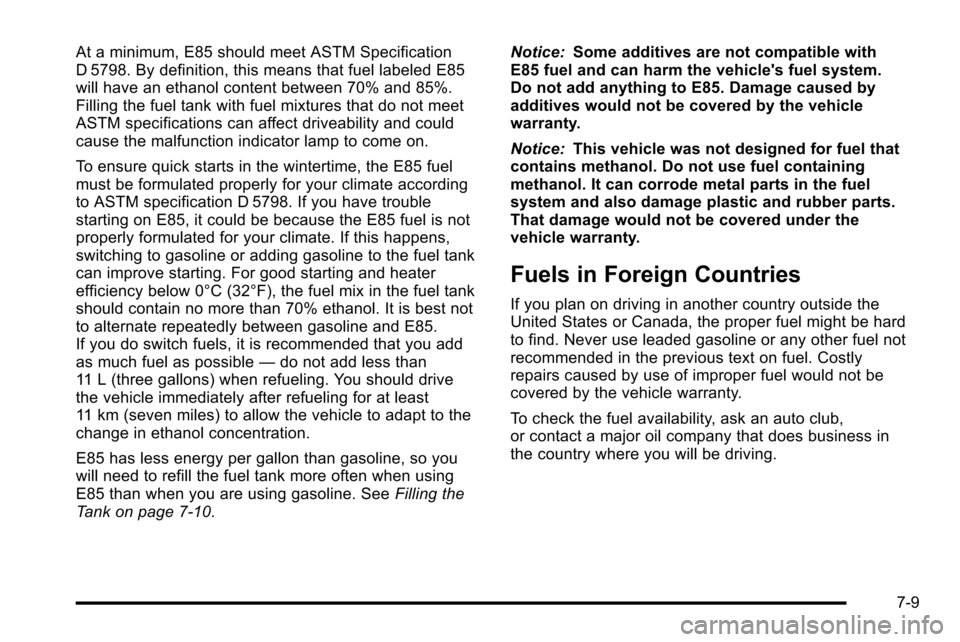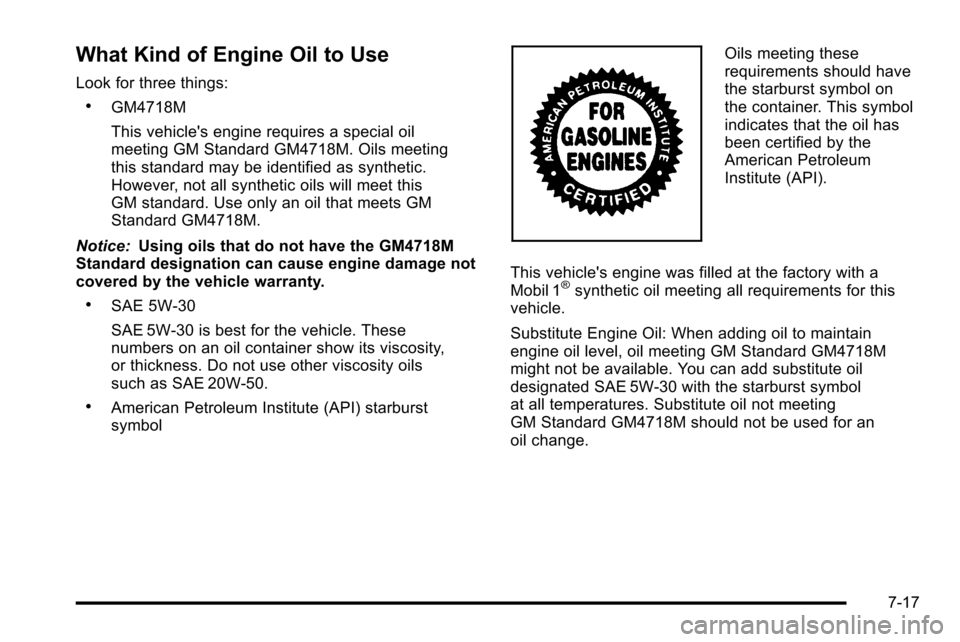adding oil CADILLAC ESCALADE EXT 2010 3.G Owners Manual
[x] Cancel search | Manufacturer: CADILLAC, Model Year: 2010, Model line: ESCALADE EXT, Model: CADILLAC ESCALADE EXT 2010 3.GPages: 580, PDF Size: 6.23 MB
Page 135 of 580

The vehicle has a Computer-Controlled Cranking
System. This feature assists in starting the engine
and protects components. If the ignition key is
turned to the START position, and then released
when the engine begins cranking, the engine will
continue cranking for a few seconds or until the
vehicle starts. If the engine does not start and the
key is held in START, cranking will be stopped
after 15 seconds to prevent cranking motor
damage. To prevent gear damage, this system also
prevents cranking if the engine is already running.
Engine cranking can be stopped by turning the
ignition switch to the ACC/ACCESSORY or
LOCK/OFF position.
Notice: Cranking the engine for long periods of
time, by returning the key to the START position
immediately after cranking has ended, can overheat
and damage the cranking motor, and drain the
battery. Wait at least 15 seconds between each try,
to let the cranking motor cool down. 2. If the engine does not start after 5‐10 seconds,
especially in very cold weather (below 0°F or
−18°C), it could be flooded with too much
gasoline. Try pushing the accelerator pedal all
the way to the floor and holding it there as you
hold the key in START for up to a maximum of
15 seconds. Wait at least 15 seconds between
each try, to allow the cranking motor to cool down.
When the engine starts, let go of the key and
accelerator. If the vehicle starts briefly but then
stops again, repeat these steps. This clears the
extra gasoline from the engine. Do not race the
engine immediately after starting it. Operate the
engine and transmission gently until the oil warms
up and lubricates all moving parts.
Notice: The engine is designed to work with the
electronics in the vehicle. If you add electrical
parts or accessories, you could change the way
the engine operates. Before adding electrical
equipment, check with your dealer/retailer. If you
do not, the engine might not perform properly.
Any resulting damage would not be covered by the
vehicle warranty.
3-33
Page 415 of 580

Section 7 Service and Appearance Care
Service. . . . . . . . . . . . . . . . . . . . . . . . . . . . . . . . . . . . . . . . . . . . . 7-4
Accessories and Modifications . . . . . . . . . . . . . . . . . . 7-4
California Proposition 65 Warning . . . . . . . . . . . . . . . 7-5
California Perchlorate Materials Requirements . . . . . . . . . . . . . . . . . . . . . . . . . . . . . . . . . 7-5
Doing Your Own Service Work . . . . . . . . . . . . . . . . . . 7-5
Adding Equipment to the Outside of the Vehicle . . . . . . . . . . . . . . . . . . . . . . . . . . . . . . . . . . . . . . . . 7-6
Fuel . . . . . . . . . . . . . . . . . . . . . . . . . . . . . . . . . . . . . . . . . . . . . . . . . 7-6
Gasoline Octane . . . . . . . . . . . . . . . . . . . . . . . . . . . . . . . . 7-7
Gasoline Specifications . . . . . . . . . . . . . . . . . . . . . . . . . 7-7
California Fuel . . . . . . . . . . . . . . . . . . . . . . . . . . . . . . . . . . 7-7
Additives . . . . . . . . . . . . . . . . . . . . . . . . . . . . . . . . . . . . . . . . 7-7
Fuel E85 (85% Ethanol) . . . . . . . . . . . . . . . . . . . . . . . . . 7-8
Fuels in Foreign Countries . . . . . . . . . . . . . . . . . . . . . . 7-9
Filling the Tank . . . . . . . . . . . . . . . . . . . . . . . . . . . . . . . . 7-10
Filling a Portable Fuel Container . . . . . . . . . . . . . . . 7-12
Checking Things Under the Hood . . . . . . . . . . . . . . .7-12
Hood Release . . . . . . . . . . . . . . . . . . . . . . . . . . . . . . . . . 7-13
Engine Compartment Overview . . . . . . . . . . . . . . . . 7-14
Engine Oil . . . . . . . . . . . . . . . . . . . . . . . . . . . . . . . . . . . . . 7-15
Engine Oil Life System . . . . . . . . . . . . . . . . . . . . . . . . 7-18
Engine Air Cleaner/Filter . . . . . . . . . . . . . . . . . . . . . . . 7-20 Automatic Transmission Fluid . . . . . . . . . . . . . . . . . . 7-22
Cooling System . . . . . . . . . . . . . . . . . . . . . . . . . . . . . . . . 7-26
Engine Coolant . . . . . . . . . . . . . . . . . . . . . . . . . . . . . . . . 7-27
Engine Overheating . . . . . . . . . . . . . . . . . . . . . . . . . . . 7-33
Overheated Engine Protection
Operating Mode . . . . . . . . . . . . . . . . . . . . . . . . . . . . . 7-35
Engine Fan Noise . . . . . . . . . . . . . . . . . . . . . . . . . . . . . 7-35
Power Steering Fluid . . . . . . . . . . . . . . . . . . . . . . . . . . 7-36
Windshield Washer Fluid . . . . . . . . . . . . . . . . . . . . . . 7-37
Brakes . . . . . . . . . . . . . . . . . . . . . . . . . . . . . . . . . . . . . . . . . 7-38
Battery . . . . . . . . . . . . . . . . . . . . . . . . . . . . . . . . . . . . . . . . . 7-41
Jump Starting . . . . . . . . . . . . . . . . . . . . . . . . . . . . . . . . . . 7-42
All-Wheel Drive . . . . . . . . . . . . . . . . . . . . . . . . . . . . . . . . . . . 7-47
Rear Axle . . . . . . . . . . . . . . . . . . . . . . . . . . . . . . . . . . . . . . . . . 7-48
Front Axle . . . . . . . . . . . . . . . . . . . . . . . . . . . . . . . . . . . . . . . . . 7-49
Headlamp Aiming . . . . . . . . . . . . . . . . . . . . . . . . . . . . . . . . 7-50
Bulb Replacement . . . . . . . . . . . . . . . . . . . . . . . . . . . . . . . . 7-53
High Intensity Discharge (HID) Lighting . . . . . . . . 7-53
Taillamps, Turn Signal, Sidemarker, Stoplamps and Back-up Lamps . . . . . . . . . . . . . . . . . . . . . . . . . 7-53
License Plate Lamp . . . . . . . . . . . . . . . . . . . . . . . . . . . . 7-55
Replacement Bulbs . . . . . . . . . . . . . . . . . . . . . . . . . . . . 7-55
7-1
Page 423 of 580

At a minimum, E85 should meet ASTM Specification
D 5798. By definition, this means that fuel labeled E85
will have an ethanol content between 70% and 85%.
Filling the fuel tank with fuel mixtures that do not meet
ASTM specifications can affect driveability and could
cause the malfunction indicator lamp to come on.
To ensure quick starts in the wintertime, the E85 fuel
must be formulated properly for your climate according
to ASTM specification D 5798. If you have trouble
starting on E85, it could be because the E85 fuel is not
properly formulated for your climate. If this happens,
switching to gasoline or adding gasoline to the fuel tank
can improve starting. For good starting and heater
efficiency below 0°C (32°F), the fuel mix in the fuel tank
should contain no more than 70% ethanol. It is best not
to alternate repeatedly between gasoline and E85.
If you do switch fuels, it is recommended that you add
as much fuel as possible—do not add less than
11 L (three gallons) when refueling. You should drive
the vehicle immediately after refueling for at least
11 km (seven miles) to allow the vehicle to adapt to the
change in ethanol concentration.
E85 has less energy per gallon than gasoline, so you
will need to refill the fuel tank more often when using
E85 than when you are using gasoline. See Filling the
Tank on page 7‑10. Notice:
Some additives are not compatible with
E85 fuel and can harm the vehicle's fuel system.
Do not add anything to E85. Damage caused by
additives would not be covered by the vehicle
warranty.
Notice: This vehicle was not designed for fuel that
contains methanol. Do not use fuel containing
methanol. It can corrode metal parts in the fuel
system and also damage plastic and rubber parts.
That damage would not be covered under the
vehicle warranty.
Fuels in Foreign Countries
If you plan on driving in another country outside the
United States or Canada, the proper fuel might be hard
to find. Never use leaded gasoline or any other fuel not
recommended in the previous text on fuel. Costly
repairs caused by use of improper fuel would not be
covered by the vehicle warranty.
To check the fuel availability, ask an auto club,
or contact a major oil company that does business in
the country where you will be driving.
7-9
Page 429 of 580

A.Engine Air Cleaner/Filter on page 7‑20.
B. Coolant Surge Tank and Pressure Cap. See Cooling System on page 7‑26.
C. Remote Positive (+) Terminal. See Jump Starting
on page 7‑42.
D. Battery on page 7‑41.
E. Engine Oil Fill Cap. See “When to Add Engine Oil”
under Engine Oil on page 7‑15.
F. Automatic Transmission Dipstick (Out of View). See “Checking the Fluid Level” underAutomatic
Transmission Fluid on page 7‑22.
G. Remote Negative (−) Terminal (GND) (Out of View). See Jump Starting on page 7‑42.
H. Engine Oil Dipstick (Out of View). See “Checking
Engine Oil” underEngine Oil on page 7‑15.
I. Engine Cooling Fan (Out of View). See Cooling
System on page 7‑26.
J. Power Steering Fluid Reservoir (Out of View). See Power Steering Fluid on page 7‑36.
K. Brake Master Cylinder Reservoir. See “Brake
Fluid” under Brakes on page 7‑38.
L. Underhood Fuse Block on page 7‑108.
M. Windshield Washer Fluid Reservoir. See “Adding
Washer Fluid” underWindshield Washer Fluid
on
page 7‑37.
Engine Oil
Checking Engine Oil
It is a good idea to check the engine oil level at each
fuel fill. In order to get an accurate reading, the oil must
be warm and the vehicle must be on level ground.
The engine oil dipstick handle is a yellow loop. See
Engine Compartment Overview
on page 7‑14for the
location of the engine oil dipstick.
1. Turn off the engine and give the oil several minutes to drain back into the oil pan. If this is not done, the
oil dipstick might not show the actual level.
2. Pull out the dipstick and clean it with a paper towel or cloth, then push it back in all the way. Remove it
again, keeping the tip down, and check the level.
7-15
Page 431 of 580

What Kind of Engine Oil to Use
Look for three things:
.GM4718M
This vehicle's engine requires a special oil
meeting GM Standard GM4718M. Oils meeting
this standard may be identified as synthetic.
However, not all synthetic oils will meet this
GM standard. Use only an oil that meets GM
Standard GM4718M.
Notice: Using oils that do not have the GM4718M
Standard designation can cause engine damage not
covered by the vehicle warranty.
.SAE 5W-30
SAE 5W-30 is best for the vehicle. These
numbers on an oil container show its viscosity,
or thickness. Do not use other viscosity oils
such as SAE 20W-50.
.American Petroleum Institute (API) starburst
symbol
Oils meeting these
requirements should have
the starburst symbol on
the container. This symbol
indicates that the oil has
been certified by the
American Petroleum
Institute (API).
This vehicle's engine was filled at the factory with a
Mobil 1
®synthetic oil meeting all requirements for this
vehicle.
Substitute Engine Oil: When adding oil to maintain
engine oil level, oil meeting GM Standard GM4718M
might not be available. You can add substitute oil
designated SAE 5W-30 with the starburst symbol
at all temperatures. Substitute oil not meeting
GM Standard GM4718M should not be used for an
oil change.
7-17
Page 442 of 580

What to Use
{WARNING:
Adding only plain water to the cooling system can
be dangerous. Plain water, or some other liquid
such as alcohol, can boil before the proper
coolant mixture will. The vehicle's coolant warning
system is set for the proper coolant mixture. With
plain water or the wrong mixture, the engine could
get too hot but you would not get the overheat
warning. The engine could catch fire and you or
others could be burned. Use a 50/50 mixture of
clean, drinkable water and DEX-COOL
®coolant.Use a 50/50 mixture of clean, drinkable water and
DEX-COOL
®coolant. If using this mixture, nothing else
needs to be added. This mixture:
.Gives freezing protection down to −34°F (−37°C),
outside temperature.
.Gives boiling protection up to 265°F (129°C),
engine temperature.
.Protects against rust and corrosion.
.Will not damage aluminum parts.
.Helps keep the proper engine temperature.
Notice: If an improper coolant mixture is used,
the engine could overheat and be badly damaged.
The repair cost would not be covered by the vehicle
warranty. Too much water in the mixture can freeze
and crack the engine, radiator, heater core, and
other parts.
Notice: If extra inhibitors and/or additives are used
in the vehicle's cooling system, the vehicle could be
damaged. Use only the proper mixture of the engine
coolant listed in this manual for the cooling system.
See Recommended Fluids and Lubricants
on
page 8‑10for more information.
7-28
Page 527 of 580

ApplicationCapacities
English Metric
Transmission Fluid (Pan Removal and Filter Replacement) 6.0 qt5.7 L
Transfer Case Fluid 1.5 qt1.4 L
Wheel Nut Torque 140 lb ft190Y
All capacities are approximate. When adding, be sure to fill to the approximate level, as recommended in this manual.
Recheck fluid after filling.
†Oil filter should be changed at every oil change.
Engine Specifications
Engine VIN CodeTransmission Spark Plug Gap
6.2L V8 FAutomatic 0.040 in (1.02 mm)
7-113
Page 532 of 580

Every Engine Oil Change
.Change engine oil and filter. SeeEngine Oilon
page 7‑15. An Emission Control Service.
.Engine coolant level check. See Engine Coolanton page 7‑27.
.Windshield washer fluid level check. See
Windshield Washer Fluid on page 7‑37.
.Tire inflation check. SeeInflation - Tire Pressureon page 7‑64.
.Tire wear inspection. See Tire Inspection and
Rotation on page 7‑70.
.Rotate tires. See Tire Inspection and Rotationon
page 7‑70.
.Fluids visual leak check (or every 12 months,
whichever occurs first). A leak in any system must
be repaired and the fluid level checked.
.Engine air cleaner filter inspection. See Engine Air
Cleaner/Filter on page 7‑20.
.Brake system inspection (or every 12 months,
whichever occurs first).
.Lubricate the front suspension, steering linkage,
and parking brake cable guides. Control arm ball
joints are maintenance‐free.
.Steering and suspension inspection. Visual
inspection for damaged, loose, or missing parts or
signs of wear.
.Engine cooling system inspection. Visual
inspection of hoses, pipes, fittings, and clamps
and replacement, if needed.
.Windshield wiper blade inspection for wear,
cracking, or contamination and windshield and
wiper blade cleaning, if contaminated. See
Windshield and Wiper Blades
on page 7‑101.
Worn or damaged wiper blade replacement.
See Windshield Wiper Blade Replacement
on
page 7‑56.
.Body hinges and latches, key lock cylinders, rear
compartment hinges, outer tailgate handle pivot
points, and folding seat hardware lubrication.
See Recommended Fluids and Lubricants
on
page 8‑10. More frequent lubrication may be
required when vehicle is exposed to a corrosive
environment. Applying silicone grease on
weatherstrips with a clean cloth makes them last
longer, seal better, and not stick or squeak.
.Restraint system component check. See Checking
the Restraint Systems on page 2‑66.
.Automatic transmission fluid level check and
adding fluid, if needed. See Automatic
Transmission Fluid on page 7‑22.
8-4